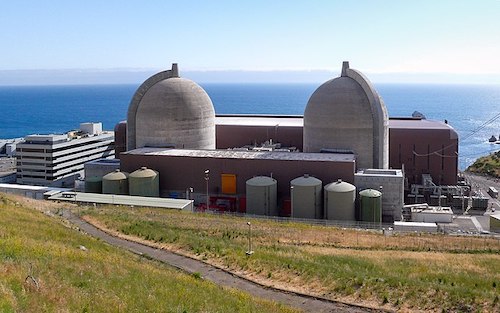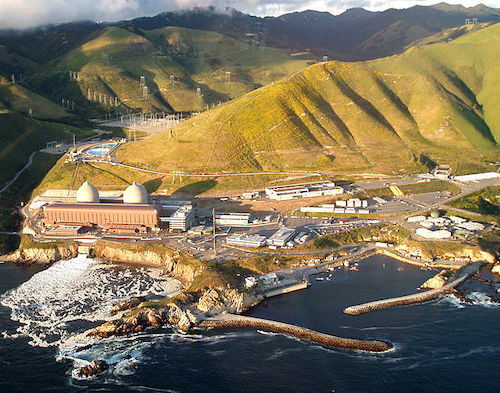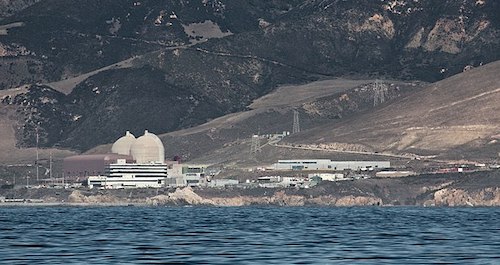
Diablo Canyon nuclear power plant. Source: Wikimedia
I am not anti-nuclear. I am supportive of efforts to develop new reactor technologies, though I expect they will take a while to deploy at scale. I also see no reason to disagree with the common wisdom that we should continue to operate existing nuclear plants where it makes sense. During his introduction to this report, Stanford professor Steven Chu pointed to Japan and Germany as cautionary examples where moving away from nuclear energy resulted in an increase in greenhouse gas emissions as gas and even coal picked up the slack in the power grid. In California we have the much closer experience with turning off the San Onofre reactor in 2012, which caused emissions from natural gas plants to increase. We don’t want that to happen again. Because of this risk, even the Union of Concerned Scientists argues for carbon pricing and standards that would help to prevent the early closure of nuclear plants.
In today’s energy economy, with inexpensive renewables and cheap natural gas pushing down the price of electricity, it can be hard to justify the continued operation of nuclear plants. Diablo Canyon also faces a significant environmental retrofit for its ocean water intake. The authors therefore focus on the business case for the plant in this report. They explore the possibility of augmenting Diablo Canyon’s electricity production with two complementary businesses that would make the facility more economically viable: fresh water production via desalination and green hydrogen production via hydrolysis. Both products are in demand in California, both would benefit substantially from cheaper on-site electricity, and both would be more profitable than power. This idea makes a lot of sense.
Yet I find parts of the report less than compelling, and other parts intriguing but with substantial open questions. In some cases I find the report to be backwards-looking. California is taking aggressive action to replace Diablo Canyon with clean energy, and has been for several years. I prefer to see California leaning into this future and using its momentum to build a clean and reliable energy system with modern technology, rather than innovating ways to keep this older plant operating. There are significant unknowns to California’s current path, including long-duration energy storage, but I believe these are more important for us to address, and more impactful, than the issues we would need to resolve to keep Diablo Canyon operating. I will give a brief overview of the report here so you can understand the basis for my hesitation.
The first chapter reviews the economics of operating the plant solely to provide electricity. It is relatively short and not the main focus of the report. It claims that the facility would provide electricity at a cost of about $42/MWh and be a viable business. However, that cost is much lower than was analyzed by PG&E and TURN just a few years ago (1). Moreover, the fourth part of the report says that the revenue that can be expected is $31/MWh (2), so I’m not sure how that pencils out. The report is also clear that if the plant were flexible it would run less in future years, as little as only 12% of the time by 2045 because of the penetration of cheaper renewables. So clearly there are some economic challenges. In addition, revenue models that look decades ahead in the rapidly evolving world of clean energy are problematic. You can’t fault the authors for using data from the 2019 planning process, but that doesn’t account for the recent CPUC call for substantially more zero-emission power. There are simplifying assumptions throughout the report that can affect the results (3), along with difficult to predict guesses about prices and capacity factors. Because of these difficulties, and the lengthy and much-debated analysis of these same issues that preceded the agreement to close the plant, I don’t put too much weight on this chapter.
I found the second chapter to be more compelling. It makes the economic case for fixing the facility’s water intake and sharing it with a co-located desalination plant. PG&E decided to close Diablo Canyon in part because of marine environmental regulations requiring an expensive retrofit for the plant’s water intake. By one estimate in the report, an intake of over 500 acres in size (!) would need to be buried beneath the ocean floor, effectively filtering the water through the sand. The authors looked at other possible solutions and conclude that submerging 27 large cylindrical 1mm screens above the ocean floor, each rotating past cleaning brushes, might do the job at a cost of $500M, which adds just $0.0023/kWh to the price of electricity. More generally, they suggest that there are several options worth considering beyond those evaluated by PG&E’s consultant Bechtel.
They then explain the benefits of co-locating a desalination plant at Diablo Canyon. Such a plant would not only share the non-trivial water intake and outfall with the nuclear facility, it would benefit from the much cheaper on-site electricity. The report states that 25-50% of the cost of desalination stems from electricity use, so fresh water can be produced much more cheaply if co-located at Diablo Canyon, where power costs only about 40% of what they would expect from the open market ($0.054/kWh vs $0.139/kWh in Table 2-1). The authors conclude that fresh water could be produced for about half the cost of that of the Carlsbad desalination plant down the coast. Moreover, the economics are more promising for fresh water than for electricity. They estimate revenue of $200/MWh when electricity is used for producing water as opposed to $31/MWh when electricity is sold as-is.
The big stumbling block, however, seems to be that only a “mega-scale” desalination facility would use a measurable fraction of the nuclear plant’s electricity. Even a desalination plant more than twelve times the size of the one in Carlsbad would use just 15% of the plant’s electricity, and the report considers two that are even larger. These mega-scale facilities are difficult to site, tough to get permitting for, and would incur extra expense to diffuse the brine going into the ocean. Perhaps more important, there may well be inadequate demand for such a large amount of water in the vicinity of the remote Diablo Canyon. Pumping water is energy intensive and therefore expensive, so it may not be economical for customers more than (say) 100 miles from the site to purchase this water as opposed to using a smaller, more local facility. (4)

Location of the Diablo Canyon nuclear power plant. Source: Wikimedia
The paper is clear about these and other potential issues, saying for example:
“If there are no offtakers nearby, the costs of constructing long pipelines could outweigh the unique benefits of a Diablo canyon project, making smaller, decentralized desalination plants located closer to the offtakers more feasible.”
and
“Siting a very large desalination plant ... near the nuclear station will be very challenging. The area is pristine, ecologically, and ought to be protected as much as possible. The mountainous terrain will pose significant challenges, as will the political landscape surrounding the lands near the plant. These challenges may be too much to overcome, and may render a mega-scale desalination project at Diablo Canyon infeasible.”
These concerns mute my enthusiasm for this option at Diablo Canyon, though I think that a large desalination plant could be a good fit at other coastal nuclear facilities in dry areas.
Finally, the third chapter considers the possibility of co-locating a green hydrogen facility at the site. Not only could it take advantage of the inexpensive fresh water and electricity supplies, but essentially free steam from the nuclear plant could cut the electricity use by 25-30% using a process called high-temperature steam electrolysis. (5) Electricity is by far the largest component of the cost of green hydrogen produced via electrolysis, so this enhancement seems to be a solid win, albeit one in early stages of commercialization. They estimate a final cost of $2.00 - $2.50/kg, which they say compares favorably with today’s prices.
What confuses me is why green hydrogen produced with nuclear power, even with the steam enhancement, is a better option than green hydrogen produced with solar power, assuming both are co-located. It is true that electricity from a fully depreciated nuclear plant is similar in cost to that from a brand-new renewables farm, but is that the right comparison? I’m also not sure what to make of costs for transporting the hydrogen from this relatively remote location. The use of water and steam is negligible when compared with the output of the plant, so it’s not clear to me that the green hydrogen price achieved in this manner is uniquely low or promising or will stand the test of time.
Stanford professor Arun Majumdar pointed out in his introduction to this paper that nuclear plants are quite inefficient at converting heat to electricity, wasting around two-thirds of the heat. That considerable leftover heat could be put to other uses. He mentioned the possibility of using it to power direct air capture, which he said can be located almost anywhere. Given our need for negative emissions, and the amount of waste heat generated by these nuclear plants, that seems like an interesting idea to consider.
I enjoyed reading this report and appreciate the creativity of the authors and their diligent efforts to examine many aspects of the problem -- economic, technical, environmental, political, and more. I especially like the idea of co-locating facilities that can take advantage of overlapping demands and excess supply. The authors are forthright not only about the opportunities but also about the challenges. Diablo Canyon is not ideally situated when it comes to co-locating mega-size facilities or finding a local market for a large supply of fresh water. And while co-locating hydrogen production with carbon-free power sources makes a lot of sense, it’s hard for me to understand why this nuclear plant is an especially good place to do this.
California is uniquely positioned and motivated to build out a clean, reliable energy system that does not rely on traditional nuclear power. The choices that California makes in this regard will not apply everywhere, but the progress that it will make in developing and deploying new energy and storage systems will be tremendously impactful. I would like to see California continue to push in that direction and let others pursue the interesting ideas in this report around improving the economics of these older nuclear plants. In the meantime, as wind power off the central coast becomes a reality, I hope we will soon see wind replacing nuclear power on Diablo’s transmission lines.

Diablo Canyon transmission lines. Source: Wikimedia
I do not know anything that the authors of this paper don’t already know; in fact, they know much more. So I wonder why they advocate for these ideas particularly in the context of Diablo Canyon. Is my analysis wrong? Or are the prospects for meeting the CPUC’s call for affordable clean energy so bleak? Are they concerned about the decommissioning? Is it especially important that California operate this facility to maintain a nuclear-skilled workforce? Do we envision hitting 80% penetration of renewables sooner than we can deploy seasonal storage at scale?
The general argument seems to be that if it’s not broken, don’t fix it. The facility is working, it is largely paid for, and it has passed all recent safety reviews. It is probably possible to address the intake problem without breaking the bank. You can make an argument that the facility can be profitable, contrary to PG&E’s analysis. So why make it harder to reduce our emissions by shutting down this plant? The authors point to California’s drought, its clean energy goals, and its land preservation goals as new factors that change the calculus of 2018 and strengthen the case for preserving Diablo Canyon.
I don’t agree that this is compelling new information. The high value of land, the danger of drought, and the urgent need for clean energy were well understood when the previous analysis was done. I don’t see the need to relitigate this. In my view, California can accomplish more by staying the course and closing Diablo Canyon in 2025 with a focus on zero-carbon replacement.
But it’s an interesting question, and as always I appreciate your thoughtful comments and questions on this topic.
Notes and References
1. According to energy attorney Matthew Freedman, in the closure proceeding PG&E forecast $107/MWh in 2030 and TURN forecast $109/MWh (nominal) between 2025 and 2044. That post contains some information about those calculations and some discussion, as does this follow-on.
2. See Table 4-6 on page 108 of the report.
3. These assumptions range from the availability of land and offshore wind, to energy system costs 20 years out, to capacity factors and energy prices, to demand profiles. The point is not to fault the authors. In some cases, they run alternative models with different assumptions. The point instead is to suggest that error bars associated with the model’s conclusions are large. There are surely thoughtfully constructed models that draw the opposite conclusion, that this nuclear plant will not be profitable as-is.
4. I have seen estimates that between 5-10% of all electricity produced in California goes to pumping and transporting water throughout the state. In this report, Table 2-3 tries to provide some information about the electricity requirements for long distance water distribution, but it seems to have some errors in the fourth column. Does it show that distribution uses around 20 kWh/m^3 per kilometer (dividing the third column by the second)? That seems high, even with a large elevation gain. At any rate, the report is clear that distribution costs add up quickly since the cost of water at the plant outlet is less than $1/m^3. On page 34 they estimate that distribution costs would add $0.02 to $0.21 per m^3 for shorter distances (up to about 115 miles). Factors like elevation and storage, as well as distance, can have a significant effect on distribution cost.
5. I appreciated the paper’s explanation of the mechanism of high-temperature steam electrolysis: “Roughly speaking, heat sets the water molecule on the chopping block, and electricity delivers the final decisive molecular chop.”
Current Climate Data (September 2021)
Global impacts, US impacts, CO2 metric, Climate dashboard (updated annually)
Quote of the week: Ex-Governor Jerry Brown didn’t go to COP26 but he did weigh in on its importance: “This is a moment to bite the bullet, not gum the marshmallow.”
Comment Guidelines
I hope that your contributions will be an important part of this blog. To keep the discussion productive, please adhere to these guidelines or your comment may be moderated:
- Avoid disrespectful, disparaging, snide, angry, or ad hominem comments.
- Stay fact-based and refer to reputable sources.
- Stay on topic.
- In general, maintain this as a welcoming space for all readers.
Comments that are written in batches by people/bots from far outside of this community are being removed.




